B2.9 Represent and create equivalent ratios and rates, using a variety of tools and models, in various contexts.
Skill: Representing and Creating Equivalent Ratios and Rates
Multiplicative reasoning is a concept that requires the ability to deal with several ideas or quantities at once. The idea is to see the values in a problem relative (multiplicative) rather than absolute (additive) terms. Multiplicative reasoning is a concept that requires the ability to deal with several ideas or quantities at once. The idea is to see the values in a problem in relative (multiplicative) rather than absolute (additive) terms. Consider the following problem, "If one dog's weight goes from 5 kg to 8 kg and another dog's weight goes from 3 kg to 6 kg, which dog gained more weight?" If the student is approaching the problem in absolute terms, they will answer that the two dogs have gained an equal amount of weight. However, in relative terms, the student will argue that the second dog gained more weight since it doubled its starting weight as compared to the first dog, which would have had to reach 10 kg for its relative weight gain to be equivalent. The following table visually illustrates the two answers to this problem. It is in the relative terms (multiplicative reasoning) that one must apply proportional reasoning.
Source: Paying attention to proportional reasoning, 2012, Ontario Ministry of Education, p. 4.
| Here is student thinking that is absolute: | Here is student thinking that is relative: |
|---|---|
| The first dog grew by 3 kg. The second dog grew by 3 kg. They grew the same amount.
Dog 1:
Dog 2:  |
The second dog grew more since he doubled his previous weight, unlike the first dog who would have needed to be 10 kg to grow by the same relative amount.
Dog 1: 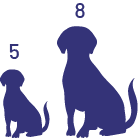
Less than doubled weight Dog 2: 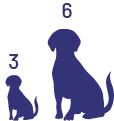
Doubled weight |
Why is this important?
Helping students bridge from additive to multiplicative thinking is complex but starts early. It forms the backbone of the mathematics curriculum and includes important and interconnected ideas such as multiplication, division, fractions, decimals, ratios, percentages and linear functions. It requires time, and a variety of situations and opportunities through which students can construct their understanding in multiple ways.
Source: Paying attention to proportional reasoning, 2012, Ontario Ministry of Education, p. 5-6.
A ratio is a comparison between 2 quantities of the same unit.
A rate, like a ratio, is also a comparison between 2 quantities, but of different units.
Ratios are present in everyday life and in several mathematical situations, notably in place values (for example the ratio between ones and thousands is \(1:\;1\;000\)), in fractions (for example \(\frac{2}{3}\) or \(2:3\)), in similar figures (for example an enlargement of \(1:3\)), in decimal numbers (for example the ratio between hundredths and tenths is \(10:1\)), in units of measurement of the metric system (for example the ratio between metres and millimetres is \( 1:1000\)).
Source: translated from Guide d’enseignement efficace des mathématiques de la 4e à la 6e, Numération et sens du nombre, Fascicule 1, Nombres naturels, p. 54.
Rates
Example 1
I buy 2 bags of rice for $10.
I can represent this rate in different ways:
- Representation using words - 2 bags of rice cost $10.
- Representation as a division - 2 bags of rice/$10.
- Representation as a fraction — \(\frac{{{\rm{2 \; bags \; of \; rice}}}}{{\$10}}\).
Using the multiplicative relationship, I can determine the rate of other quantities of rice, namely equivalent rates.

For 4 bags of rice, the cost will be $20. Four bags is twice as much as two bags, so the price is twice as much as $10.
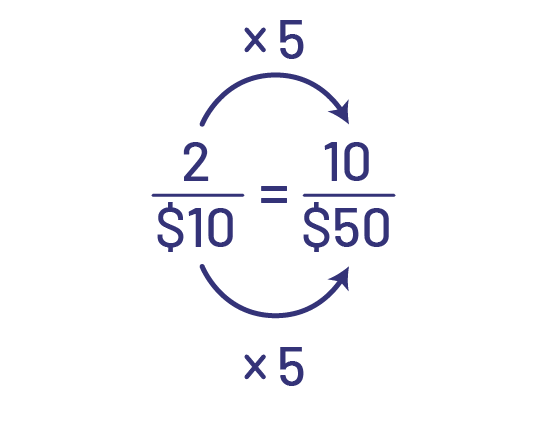
For 10 bags of rice, the cost will be $50. Ten bags is 5 times more than 2 bags, so the price is 5 times more than $10 for 5 bags.
We can also determine the unit rate, which is the cost per 1 bag of rice, using division.

For 1 bag of rice, the cost will be $5. One bag costs half as much as 2 bags, so the cost is half as much as $10. So the unit rate is $5/1 bag of rice.
Equivalent rates can be represented in a ratio table with emphasis on the multiplicative, not additive, relationship.
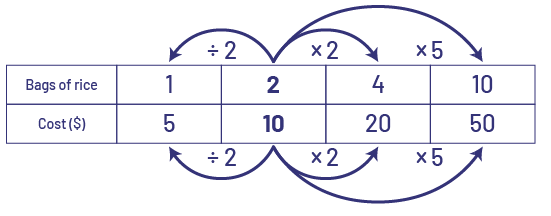
Rates are used in everyday life. Students can be supported to find different examples related to measurements (for example, I run 12 km per hour, the electric bike goes 35 km per hour, etc.) and costs (for example, $3 for 12 apples, $15/hour, etc.).
Students should solve problems representing multiplicative relationships involving rates using familiar contexts.
Example 2
If you get $24 for 2 hours of work, how much money do you get for working 4 hours? The student should observe that 4 hours is double or twice as much as 2 hours so the amount of money will also double, so $48. If we divide by 2, we can find the unit rate, which is the amount of money received for 1 hour of work ($12/hour).
These relationships can be represented in a ratio table with emphasis on the multiplicative, not additive, relationship.
In this ratio table, we can also recognize that there is a proportional relationship between the number of hours worked and the amount of money received, that is, × 12. We multiply the number of hours worked by 12 to get the amount of money received.

The ratio table can be constructed without listing the values in ascending order or without listing all the values. It is sometimes easier to determine the solution to the problem by using the proportionality relation as shown in the following example.
Example 3
Abdala buys cold cuts to make sandwiches for the school picnic. Each kilogram of meat costs $12 and will make 10 sandwiches. How much will the meat cost to make 25 sandwiches?
The following number lines show two different ways to solve the problem.
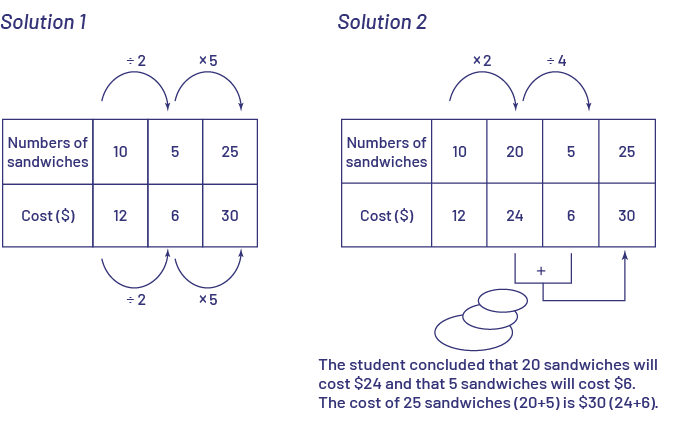
This use of the ratio table in a proportionality situation does not necessarily have to be taught since students, in problem-solving situations, can note it on their own.
The double number line also highlights relationships that can be used to solve a problem. It can, for example, be used instead of a ratio table to solve the previous problem.

Students locate ratios on the number line that are equivalent to the one given in order to solve the problem. They can choose the ratios according to their needs and their understanding of the problem. Here are two different ways to solve the problem using a double number line.
Solution 1

Solution 2
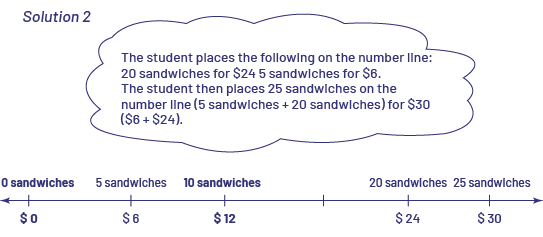
The difference between using a ratio table and a double number line to represent a proportionality situation is the order in which the values that represent ratios are placed. On a double number line, the numbers are placed in ascending order at constant intervals, whereas in the table of values, they are placed in the order that corresponds to the reasoning used to solve the situation.
Source: translated from Guide d'enseignement efficace des mathématiques de la 4e à la 6e année, Numération et sens du nombre, Fascicule 1, Nombres naturels, p. 52-53.
Ratios
There is a relationship of proportionality between two quantities when these quantities increase or decrease simultaneously by the same factor.
Example 1
To enable students to complete an activity, teachers distribute straws as follows:
- the student who works alone receives 4 straws;
- a team of 2 students receives 8 straws;
- a team of 3 students receives 12 straws.
A study of the pattern in this relationship allows us to recognize that the number of students and the number of straws increases proportionally (multiple of 4 for 2 students, multiple of 4 for 3 students). It then becomes easy to determine that a group of 6 students will receive 24 straws (multiple of 4). The proportional relationship between the number of students and the number of straws can be represented by the equality between the ratios (for example, "="). Such an equality between 2 ratios is called a proportion.
The following situation, on the other hand, does not have a proportional relationship.
Example 2
To enable students to complete an activity, teachers distribute straws as follows:
- the student who works alone receives 5 straws;
- a team of 2 students receives 9 straws;
- a team of 3 students receives 13 straws.
In this situation, it is impossible to establish an equality between two ratios (for example \(\frac{1}{5}\; \ne \;\frac{3}{{13}}\)).
The analysis of proportional relationships is done by applying proportional reasoning. This reasoning is used when comparing two ratios and recognizing a multiplicative relationship. Note that multiplicative relations include the operation of division, since any division can be transformed into multiplication (for example, dividing by 2 is equivalent to multiplying by \(\frac{1}{2}\)).
The ability to use proportional reasoning develops throughout the learning of mathematics. For example, teachers ask primary students to determine the number of pieces in 3 chocolate bars if a bar contains 8 pieces. This is a multiplicative relationship since the number of pieces is 8 times greater than the number of bars (ratio of 8 to 1). However, to solve this kind of problem, students will first use repeated addition \(\left( {8\; + \;8\; + \;8} \right)\). Later, when they have been exposed to the concept of multiplication, they can solve it by multiplying \(\left( {8\; \times \;3} \right)\), which is a first step towards using proportional reasoning.
The terms ratio and proportion, and their related notations (for example, 2:3), are part of the junior mathematics curriculum. In addition, students will learn about and develop strategies for algebraically solving a problem involving proportionality. Beginning in Grade 4 , the study of proportional relationships focused on the recognizing and describing multiplicative relationship in a variety of problem-solving situations. Students intuitively use proportional reasoning to solve problems involving 2 quantities that are in a ratio of 1 to many (for example, 1 bar for 8 pieces), many to 1 (for example, 3 people per table) or many to many (for example, 2 litres of juice for 5 people). They also use concrete and visual (semi-concrete) models, ratio tables or number lines.
Example 3
For track and field day, students in Ms. Guerin's class prepare juice for the runners. For each container of juice concentrate, they need to add 3 containers of water. How many containers of water will they need to add to 4 containers of juice concentrate?
Solution Using Visuals

This will require 12 containers of water (\(4\; \times \;3\) containers of water).
Solution Using a Ratio Table

In a ratio table that represents a situation of proportionality, the factor that connects corresponding quantities is constant. In the example above, the multiplicative relationship "times 3" between the number of containers of juice and the number of containers of water is easily recognized. In addition, this ratio table allows us to establish proportions (for example, \(\frac{1}{3}\; = \;\frac{4}{{12}}\)) for different numbers of juice containers or water containers.
Source: translated from Guide d'enseignement efficace des mathématiques de la 4e à la 6e année, Numération et sens du nombre, Fascicule 1, Nombres naturels, p. 49-51.
Knowledge: Ratios
Relationship between two quantities expressed as the quotient of the numbers that characterize them.

For example, in the set of 5 marbles above,
- there is a ratio of 2 to 3 (\(\frac{2}{3}\;{\rm{or}}\;{\rm{2}}\;{\rm{:}}\;{ \rm{3}}\)) between the number of white marbles and the number of blue marbles. (part: part ratio)
- there is a ratio of 2 to 5 (\(\frac{2}{5}\;{\rm{or}}\;{\rm{2}}\;{\rm{:}}\;5 \)) between the number of white marbles and the total number of marbles. This can be interpreted as \(\frac{2}{5}\) marbles are white. (part: whole ratio)
Source: translated from Guide d'enseignement efficace des mathématiques de la 4e à la 6e année, Numération et sens du nombre, Fascicule 1, Nombres naturels, p. 49.
Knowledge: Equivalent Ratios
When two ratios can be increased or decreased simultaneously by the same factor.
Example
The ratio \(3\;:\;5\) is equivalent to the ratio \(6\;:\;10\), and is obtained by multiplying the terms of the first ratio by the same factor of 2.
Note: Equivalent ratios are determined in the same way as equivalent fractions, that is, by multiplying or dividing each term (or part) of the ratio by the same factor.
Source: translated from En avant, les maths! 5e, CM, Nombres, p. 2.
Knowledge: Determining Proportionality
Two ratios are proportional if the terms of one are obtained by multiplying or dividing the terms of the other by the same number (factor).

Source: translated from En avant, les maths! 5e, CM, Nombres, p. 2.
Knowledge: Ratio Table
A model that can be used to develop an understanding of multiplication, equivalent fractions, division, and proportional reasoning. Moving between ratios involves multiplying or dividing the terms of the ratio by the same factor.
| Flour Bags | 1 | 3 | 4 | 6 | ? |
| Water | 3 | 9 | ? | ? | 6 |
Source: translated from En avant, les maths! 5e, CM, Nombres, p. 2.
Knowledge: Rate
A rate describes the relationship between two quantities expressed in different units (for example, objects with dollars or kilometres with hours).
Source: translated from En avant, les maths! 4e, CM, Nombres, p. 2.
Knowledge: Equivalent Rates
Rate that represents the same ratio between two quantities or measures.
Example
If 12 cookies were eaten by 4 people, the rate would be 12 cookies per 4 people and an equivalent rate would be 6 cookies per 2 people.
Note: Equivalent rates are determined in the same way as equivalent fractions, that is by multiplying or dividing each term (or part) of the rate by the same factor. If the value of a term (or part) of a rate is changed, there will be a direct effect on the rate (for example, if the price of bananas per kilogram is changed, then there will be an effect on the total cost of the purchase).
Source: translated from En avant, les maths! 5e, CM, Nombres, p. 3.
Knowledge: Unit Rate
A rate that, when expressed as a ratio, has a second term that is one unit.
Example
3 cookies for 1 person.
Source: translated from En avant, les maths! 5e, CM, Nombres, p. 3.

